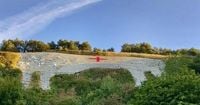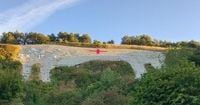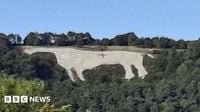On the afternoon of September 9, 2025, one of North Yorkshire’s most iconic landmarks, the Kilburn White Horse, became the center of a criminal investigation after a St George’s flag—England’s red cross—appeared emblazoned across its chalky surface. The incident, which was reported to North Yorkshire Police just after 2pm, has left local authorities, heritage specialists, and the surrounding community scrambling for answers and restoration plans.
The Kilburn White Horse, carved into the southern slopes of Sutton Bank in the North York Moors National Park, is Britain’s largest white horse by surface area. Measuring a staggering 318 feet (97 meters) long and 220 feet (67 meters) high, and covering about 1.6 acres, it’s not just a local point of pride but a national treasure dating back to 1857. According to local accounts and the Kilburn White Horse Association, the figure was initiated by Thomas Taylor of Kilburn, inspired by the more ancient Uffington White Horse, and brought to life by volunteers wielding tons of lime to whiten the exposed sandstone.
But on this particular Tuesday, the serene white silhouette was jolted into controversy. Images shared online quickly spread, showing a vivid red cross—thought to be made from fabric—laid across the landmark. The police, Forestry England (which manages the site), and the North York Moors National Park Authority all confirmed their involvement. As the news broke, a spokesperson for North Yorkshire Police stated, “We received a report that criminal damage has been caused to the White Horse at Kilburn. It was reported to us just after 2pm on Tuesday 9 September.” The force urged anyone with information to call 101 and provide reference NYP-09092025-0267.
The precise method of the flag’s placement remains unclear. Was it painted, or was it a flag or ribbon tied down? While speculation swirled, local smallholder Niki Otterburn, who witnessed the aftermath, offered some clarity: “It’s not enormous and looks like it’s made of material, not paint. It’s well tied down. They’re lucky they didn’t break their necks.” Otterburn also reported seeing two people on e-bikes acting suspiciously near the landmark earlier that day, a detail now being considered by investigators.
Forestry England, responsible for the ongoing maintenance of the White Horse, was quick to act. A spokesperson emphasized the seriousness of the incident: “We are aware of the symbol that has appeared on the White Horse at Kilburn. Our heritage specialists are assessing the impact this has had on the horse’s condition and are working on a plan to restore it.” They added, “We are working closely with the police to try and find who did the damage to this important asset of local and cultural heritage.” The agency also reminded the public that signage at the site warns visitors to keep off the landmark due to its loose surface and steep ground, both for safety and to prevent damage.
This wasn’t an isolated event. Earlier that same day, the Westbury White Horse in Wiltshire—another of England’s famed chalk figures—was also temporarily adorned with a St George’s flag made from red fabric. The near-simultaneous appearance of the symbols at two distant sites has prompted questions about coordination and motive, though police have yet to connect the incidents publicly.
The Kilburn White Horse has witnessed its share of history and drama. Created in November 1857, it’s been both a community project and a national symbol. During World War II, the figure was even camouflaged to prevent enemy aircraft from using it as a navigational landmark. Over the decades, regular maintenance has been funded by public subscriptions, with major restorations—like the one in 1925, funded by readers of the Yorkshire Evening Post—ensuring its survival for future generations. A tablet at the car park below the horse credits Thomas Taylor for initiating the creation and notes the historical restoration efforts.
As the investigation unfolds, the local authorities have been keen to involve the public. Police have repeatedly asked anyone with information to come forward, especially those who may have seen suspicious activity or have images from the area. The reference number NYP-09092025-0267 has been provided for tips. “Thank you to the public for their continued support and we urge anyone with information to contact the police online or by calling 101,” Forestry England said in a statement.
For many in the region and beyond, the Kilburn White Horse is more than just a tourist attraction—it’s a living piece of history. It’s the most northerly chalk hill figure in England, a fact that adds to its uniqueness and the sense of responsibility felt by those who care for it. The figure’s size, visibility, and historical resonance make any act of vandalism particularly impactful. As the BBC noted, Forestry England is “working closely with the police to try and find who did the damage to this important asset of local and cultural heritage.”
The incident has also reignited conversations about access and preservation. Forestry England’s signage has long advised visitors to keep off the horse, warning, “It has a loose surface on very steep ground.” The challenge of maintaining such a large, exposed figure—especially one that’s so accessible—has always been considerable. But as recent events show, the risks extend beyond natural erosion and into the realm of deliberate interference.
In the days following the incident, heritage specialists have been assessing the damage and developing a restoration plan. The hope is that, with swift action and community vigilance, the Kilburn White Horse will soon be returned to its original state, unmarred and gleaming against the hillside as it has for nearly 170 years. As the investigation continues, the story serves as a reminder of both the fragility and resilience of Britain’s cultural landmarks—and the collective effort required to protect them.






